+ データを開く
データを開く
- 基本情報
基本情報
| 登録情報 | データベース: PDB / ID: 6r7n | ||||||
|---|---|---|---|---|---|---|---|
| タイトル | Structural basis of Cullin-2 RING E3 ligase regulation by the COP9 signalosome | ||||||
 要素 要素 |
| ||||||
 キーワード キーワード | LIGASE / Cullin-Ring E3 Ligases (CRLs) COP9 signalosome (CSN) deneddylation VHL tumour suppressor substrate receptor | ||||||
| 機能・相同性 |  機能・相同性情報 機能・相同性情報COP9 signalosome assembly / trophectodermal cell proliferation / GTPase inhibitor activity / deNEDDylase activity / protein deneddylation / regulation of protein neddylation / activation of NF-kappaB-inducing kinase activity / cullin-RING-type E3 NEDD8 transferase / NEDD8 transferase activity / COP9 signalosome ...COP9 signalosome assembly / trophectodermal cell proliferation / GTPase inhibitor activity / deNEDDylase activity / protein deneddylation / regulation of protein neddylation / activation of NF-kappaB-inducing kinase activity / cullin-RING-type E3 NEDD8 transferase / NEDD8 transferase activity / COP9 signalosome / cullin-RING ubiquitin ligase complex / cellular response to chemical stress / Cul7-RING ubiquitin ligase complex / ubiquitin-dependent protein catabolic process via the C-end degron rule pathway / target-directed miRNA degradation / Loss of Function of FBXW7 in Cancer and NOTCH1 Signaling / elongin complex / positive regulation of protein autoubiquitination / RNA polymerase II transcription initiation surveillance / protein neddylation / NEDD8 ligase activity / VCB complex / RHOBTB1 GTPase cycle / negative regulation of response to oxidative stress / Cul5-RING ubiquitin ligase complex / regulation of DNA damage response, signal transduction by p53 class mediator / SCF ubiquitin ligase complex / inner cell mass cell proliferation / Cul2-RING ubiquitin ligase complex / negative regulation of type I interferon production / ubiquitin-ubiquitin ligase activity / Cul4A-RING E3 ubiquitin ligase complex / SCF-dependent proteasomal ubiquitin-dependent protein catabolic process / Cul4-RING E3 ubiquitin ligase complex / Cul3-RING ubiquitin ligase complex / Cul4B-RING E3 ubiquitin ligase complex / ubiquitin ligase complex scaffold activity / negative regulation of mitophagy / Prolactin receptor signaling / response to light stimulus / cullin family protein binding / skeletal muscle cell differentiation / Pausing and recovery of Tat-mediated HIV elongation / Tat-mediated HIV elongation arrest and recovery / HIV elongation arrest and recovery / Pausing and recovery of HIV elongation / protein monoubiquitination / Tat-mediated elongation of the HIV-1 transcript / Formation of HIV-1 elongation complex containing HIV-1 Tat / Formation of HIV elongation complex in the absence of HIV Tat / protein K48-linked ubiquitination / RNA Polymerase II Transcription Elongation / Nuclear events stimulated by ALK signaling in cancer / Formation of RNA Pol II elongation complex / Regulation of BACH1 activity / JNK cascade / transcription-coupled nucleotide-excision repair / RNA Polymerase II Pre-transcription Events / regulation of cellular response to insulin stimulus / positive regulation of TORC1 signaling / post-translational protein modification / intrinsic apoptotic signaling pathway / negative regulation of insulin receptor signaling pathway / T cell activation / Degradation of DVL / Recognition of DNA damage by PCNA-containing replication complex / Degradation of GLI1 by the proteasome / transcription corepressor binding / GSK3B and BTRC:CUL1-mediated-degradation of NFE2L2 / Negative regulation of NOTCH4 signaling / Vif-mediated degradation of APOBEC3G / Hedgehog 'on' state / Degradation of GLI2 by the proteasome / GLI3 is processed to GLI3R by the proteasome / DNA Damage Recognition in GG-NER / FBXL7 down-regulates AURKA during mitotic entry and in early mitosis / cellular response to amino acid stimulus / TP53 Regulates Transcription of DNA Repair Genes / Inactivation of CSF3 (G-CSF) signaling / transcription initiation at RNA polymerase II promoter / Degradation of beta-catenin by the destruction complex / transcription elongation by RNA polymerase II / Evasion by RSV of host interferon responses / Oxygen-dependent proline hydroxylation of Hypoxia-inducible Factor Alpha / NOTCH1 Intracellular Domain Regulates Transcription / Dual Incision in GG-NER / Transcription-Coupled Nucleotide Excision Repair (TC-NER) / Formation of TC-NER Pre-Incision Complex / Constitutive Signaling by NOTCH1 PEST Domain Mutants / Constitutive Signaling by NOTCH1 HD+PEST Domain Mutants / G1/S transition of mitotic cell cycle / negative regulation of canonical Wnt signaling pathway / Formation of Incision Complex in GG-NER / Regulation of expression of SLITs and ROBOs / RING-type E3 ubiquitin transferase / Interleukin-1 signaling / Orc1 removal from chromatin / Dual incision in TC-NER / Gap-filling DNA repair synthesis and ligation in TC-NER / Regulation of RAS by GAPs 類似検索 - 分子機能 | ||||||
| 生物種 |  Homo sapiens (ヒト) Homo sapiens (ヒト) | ||||||
| 手法 | 電子顕微鏡法 / 単粒子再構成法 / クライオ電子顕微鏡法 / 解像度: 6.5 Å | ||||||
 データ登録者 データ登録者 | Faull, S.V. / Lau, A.M.C. / Martens, C. / Ahdash, Z. / Yebenes, H. / Schmidt, C. / Beuron, F. / Cronin, N.B. / Morris, E.P. / Politis, A. | ||||||
| 資金援助 |  英国, 1件 英国, 1件
| ||||||
 引用 引用 |  ジャーナル: Nat Commun / 年: 2019 ジャーナル: Nat Commun / 年: 2019タイトル: Structural basis of Cullin 2 RING E3 ligase regulation by the COP9 signalosome. 著者: Sarah V Faull / Andy M C Lau / Chloe Martens / Zainab Ahdash / Kjetil Hansen / Hugo Yebenes / Carla Schmidt / Fabienne Beuron / Nora B Cronin / Edward P Morris / Argyris Politis /    要旨: Cullin-Ring E3 Ligases (CRLs) regulate a multitude of cellular pathways through specific substrate receptors. The COP9 signalosome (CSN) deactivates CRLs by removing NEDD8 from activated Cullins. ...Cullin-Ring E3 Ligases (CRLs) regulate a multitude of cellular pathways through specific substrate receptors. The COP9 signalosome (CSN) deactivates CRLs by removing NEDD8 from activated Cullins. Here we present structures of the neddylated and deneddylated CSN-CRL2 complexes by combining single-particle cryo-electron microscopy (cryo-EM) with chemical cross-linking mass spectrometry (XL-MS). These structures suggest a conserved mechanism of CSN activation, consisting of conformational clamping of the CRL2 substrate by CSN2/CSN4, release of the catalytic CSN5/CSN6 heterodimer and finally activation of the CSN5 deneddylation machinery. Using hydrogen-deuterium exchange (HDX)-MS we show that CRL2 activates CSN5/CSN6 in a neddylation-independent manner. The presence of NEDD8 is required to activate the CSN5 active site. Overall, by synergising cryo-EM with MS, we identify sensory regions of the CSN that mediate its stepwise activation and provide a framework for understanding the regulatory mechanism of other Cullin family members. | ||||||
| 履歴 |
|
- 構造の表示
構造の表示
| ムービー |
 ムービービューア ムービービューア |
|---|---|
| 構造ビューア | 分子:  Molmil Molmil Jmol/JSmol Jmol/JSmol |
- ダウンロードとリンク
ダウンロードとリンク
- ダウンロード
ダウンロード
| PDBx/mmCIF形式 |  6r7n.cif.gz 6r7n.cif.gz | 889.6 KB | 表示 |  PDBx/mmCIF形式 PDBx/mmCIF形式 |
|---|---|---|---|---|
| PDB形式 |  pdb6r7n.ent.gz pdb6r7n.ent.gz | 732.9 KB | 表示 |  PDB形式 PDB形式 |
| PDBx/mmJSON形式 |  6r7n.json.gz 6r7n.json.gz | ツリー表示 |  PDBx/mmJSON形式 PDBx/mmJSON形式 | |
| その他 |  その他のダウンロード その他のダウンロード |
-検証レポート
| 文書・要旨 |  6r7n_validation.pdf.gz 6r7n_validation.pdf.gz | 800.8 KB | 表示 |  wwPDB検証レポート wwPDB検証レポート |
|---|---|---|---|---|
| 文書・詳細版 |  6r7n_full_validation.pdf.gz 6r7n_full_validation.pdf.gz | 1 MB | 表示 | |
| XML形式データ |  6r7n_validation.xml.gz 6r7n_validation.xml.gz | 120.6 KB | 表示 | |
| CIF形式データ |  6r7n_validation.cif.gz 6r7n_validation.cif.gz | 174.2 KB | 表示 | |
| アーカイブディレクトリ |  https://data.pdbj.org/pub/pdb/validation_reports/r7/6r7n https://data.pdbj.org/pub/pdb/validation_reports/r7/6r7n ftp://data.pdbj.org/pub/pdb/validation_reports/r7/6r7n ftp://data.pdbj.org/pub/pdb/validation_reports/r7/6r7n | HTTPS FTP |
-関連構造データ
| 関連構造データ |  4744MC 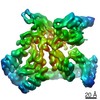 4736C  4739C  4741C  4742C 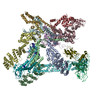 6r6hC  6r7fC  6r7hC  6r7iC M: このデータのモデリングに利用したマップデータ C: 同じ文献を引用 ( |
|---|---|
| 類似構造データ |
- リンク
リンク
- 集合体
集合体
| 登録構造単位 | 
|
|---|---|
| 1 |
|
- 要素
要素
-COP9 signalosome complex subunit ... , 5種, 5分子 ADHCB
| #1: タンパク質 | 分子量: 55606.496 Da / 分子数: 1 / 由来タイプ: 組換発現 / 由来: (組換発現)  Homo sapiens (ヒト) / 遺伝子: GPS1, COPS1, CSN1 Homo sapiens (ヒト) / 遺伝子: GPS1, COPS1, CSN1発現宿主:  参照: UniProt: Q13098 |
|---|---|
| #2: タンパク質 | 分子量: 46322.688 Da / 分子数: 1 / 由来タイプ: 組換発現 / 由来: (組換発現)  Homo sapiens (ヒト) / 遺伝子: COPS4, CSN4 Homo sapiens (ヒト) / 遺伝子: COPS4, CSN4発現宿主:  参照: UniProt: Q9BT78 |
| #3: タンパク質 | 分子量: 22258.342 Da / 分子数: 1 / 由来タイプ: 組換発現 / 由来: (組換発現)  Homo sapiens (ヒト) / 遺伝子: COPS8, CSN8 Homo sapiens (ヒト) / 遺伝子: COPS8, CSN8発現宿主:  参照: UniProt: Q99627 |
| #7: タンパク質 | 分子量: 45606.543 Da / 分子数: 1 / 由来タイプ: 組換発現 / 由来: (組換発現)  Homo sapiens (ヒト) / 遺伝子: COPS3, CSN3 Homo sapiens (ヒト) / 遺伝子: COPS3, CSN3発現宿主:  参照: UniProt: Q9UNS2 |
| #10: タンパク質 | 分子量: 51664.570 Da / 分子数: 1 / 由来タイプ: 組換発現 / 由来: (組換発現)  Homo sapiens (ヒト) / 遺伝子: COPS2, CSN2, TRIP15 Homo sapiens (ヒト) / 遺伝子: COPS2, CSN2, TRIP15発現宿主:  参照: UniProt: P61201 |
-タンパク質 , 5種, 5分子 PQRGO
| #4: タンパク質 | 分子量: 11748.406 Da / 分子数: 1 / 由来タイプ: 組換発現 / 由来: (組換発現)  Homo sapiens (ヒト) / 遺伝子: ELOB, TCEB2 Homo sapiens (ヒト) / 遺伝子: ELOB, TCEB2発現宿主:  参照: UniProt: Q15370 |
|---|---|
| #5: タンパク質 | 分子量: 12485.135 Da / 分子数: 1 / 由来タイプ: 組換発現 / 由来: (組換発現)  Homo sapiens (ヒト) / 遺伝子: ELOC, TCEB1 Homo sapiens (ヒト) / 遺伝子: ELOC, TCEB1発現宿主:  参照: UniProt: Q15369 |
| #6: タンパク質 | 分子量: 10092.631 Da / 分子数: 1 / 由来タイプ: 組換発現 / 由来: (組換発現)  Homo sapiens (ヒト) Homo sapiens (ヒト)発現宿主:  参照: UniProt: P62877*PLUS |
| #8: タンパク質 | 分子量: 23944.400 Da / 分子数: 1 / 由来タイプ: 組換発現 / 由来: (組換発現)  Homo sapiens (ヒト) Homo sapiens (ヒト)発現宿主:  参照: UniProt: Q9H9Q2*PLUS |
| #9: タンパク質 | 分子量: 87098.930 Da / 分子数: 1 / 由来タイプ: 組換発現 / 由来: (組換発現)  Homo sapiens (ヒト) / 遺伝子: CUL2 Homo sapiens (ヒト) / 遺伝子: CUL2発現宿主:  参照: UniProt: Q13617 |
-非ポリマー , 1種, 3分子 
| #11: 化合物 |
|---|
-実験情報
-実験
| 実験 | 手法: 電子顕微鏡法 |
|---|---|
| EM実験 | 試料の集合状態: PARTICLE / 3次元再構成法: 単粒子再構成法 |
- 試料調製
試料調製
| 構成要素 | 名称: CNS (COP9 Signalosome) with CSN5/CSN6 the catalytic heterodimer complexed with CUL2 (CUL2, ElonginB, ElongingC, Rbx1 and VDL) タイプ: COMPLEX / Entity ID: #1-#10 / 由来: RECOMBINANT |
|---|---|
| 分子量 | 実験値: NO |
| 由来(天然) | 生物種:  Homo sapiens (ヒト) Homo sapiens (ヒト) |
| 由来(組換発現) | 生物種:  |
| 緩衝液 | pH: 7.5 詳細: 15 mM HEPES pH 7.5 100 mM NaCl 0.5 mM DTT 1% Glycerol |
| 試料 | 包埋: NO / シャドウイング: NO / 染色: NO / 凍結: YES |
| 急速凍結 | 装置: FEI VITROBOT MARK IV / 凍結剤: ETHANE |
- 電子顕微鏡撮影
電子顕微鏡撮影
| 実験機器 |  モデル: Titan Krios / 画像提供: FEI Company |
|---|---|
| 顕微鏡 | モデル: FEI TITAN KRIOS |
| 電子銃 | 電子線源:  FIELD EMISSION GUN / 加速電圧: 300 kV / 照射モード: FLOOD BEAM FIELD EMISSION GUN / 加速電圧: 300 kV / 照射モード: FLOOD BEAM |
| 電子レンズ | モード: BRIGHT FIELD / 最大 デフォーカス(公称値): 3000 nm / 最小 デフォーカス(公称値): 1800 nm |
| 試料ホルダ | 試料ホルダーモデル: FEI TITAN KRIOS AUTOGRID HOLDER |
| 撮影 | 電子線照射量: 45 e/Å2 / 検出モード: COUNTING フィルム・検出器のモデル: GATAN K2 SUMMIT (4k x 4k) |
- 解析
解析
| CTF補正 | タイプ: PHASE FLIPPING AND AMPLITUDE CORRECTION |
|---|---|
| 対称性 | 点対称性: C1 (非対称) |
| 3次元再構成 | 解像度: 6.5 Å / 解像度の算出法: FSC 0.143 CUT-OFF / 粒子像の数: 22471 / 対称性のタイプ: POINT |
| 原子モデル構築 | プロトコル: FLEXIBLE FIT |
 ムービー
ムービー コントローラー
コントローラー





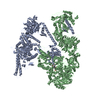
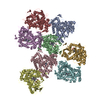
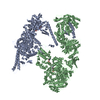
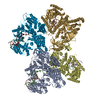
 PDBj
PDBj















